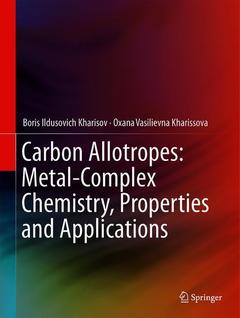Description
Carbon Allotropes: Metal-Complex Chemistry, Properties and Applications, 1st ed. 2019
Authors: Kharisov Boris Ildusovich, Kharissova Oxana Vasilievna
Language: English
Subjects for Carbon Allotropes: Metal-Complex Chemistry, Properties...:
Approximative price 210.99 €
In Print (Delivery period: 15 days).
Add to cartSupport: Print on demand
Description
/li>Contents
/li>Biography
/li>Comment
/li>
This book provides a detailed description of metal-complex functionalized carbon allotrope forms, including classic (such as graphite), rare (such as M- or T-carbon), and nanoforms (such as carbon nanotubes, nanodiamonds, etc.). Filling a void in the nanotechnology literature, the book presents chapters generalizing the synthesis, structure, properties, and applications of all known carbon allotropes. Metal-complex composites of carbons are described, along with several examples of their preparation and characterization, soluble metal-complex carbon composites, cost-benefit data, metal complexes as precursors of carbon allotropes, and applications. A lab manual on the synthesis and characterization of carbon allotropes and their metal-complex composites is included.
- Provides a complete description of all carbon allotropes, both classic and rare, as well as carbon nanostructures and their metal-complex composites;
- Contains a laboratory manual of experiments on the synthesis and characterization of metal-complex carbon composites;
- Discusses applications in diverse fields, such as catalysis on supporting materials, water treatment, sensors, drug delivery, and devices.
Dr. Boris I. Kharisov (born in 1964, in Russia, has lived in Mexico from 1994, and naturalized in Mexico in 2003) is currently a Professor and Researcher at the Universidad Autónoma de Nuevo León (UANL). He took part in the liquidation of the consequences of the Chernobyl accident, working in the contaminated zone in 1987. Degrees: M.Sc. in 1986, in radiochemistry and a PhD in inorganic chemistry in 1993, from the Moscow State University, Russia; Dr. Hab. in physical chemistry in 2006 from Rostov State University, Russia. Specialties: Materials chemistry, coordination and inorganic chemistry, phthalocyanines, ultrasound, nanotechnology, chemical treatment of petroleum, environmental remediation. Memberships: Mexican Academy of Science, National Researchers System (SNI, Level III). He is the co-author of ten books, 168 articles, eleven book chapters, and holds eight patents. Co-editor: Three invited special issues of international journals. He is the member of the Editorial board of four journals. Dr. Kharisov has three children. His biography was published in: “Who is Who in the World”, “Outstanding People of the Twentieth Century”, and so on.
Dr. Oxana V. Kharissova (born in 1969 in Ukraine, former USSR, has lived in Mexico from 1995, and naturalized in Mexico in 2004) is currently a Professor and Researcher at the Universidad Autónoma de Nuevo León (UANL). Degrees: M.Sc. in 1994, in crystallography from Moscow State University, Russia, and a Ph.D. in Materials from the Universidad Autónoma de Nuevo León, Mexico. Memberships: National Researchers System (SNI, Level II), Materials Research Society, Mexican Academy of Science. She is the co-author of six books, 12 book chapters, 85 articles, and holds eight patents. Specialties: Materials, nanotechnology (carbon nanotubes, graphene, nanostructurized metals, fullerenes), microwave irradiation and crys
Provides a complete description of all carbon allotropes, both classic and rare, as well as carbon nanostructures and their metal-complex composites
Contains a laboratory manual of experiments on the synthesis and characterization of metal-complex carbon composites
Discusses applications in diverse fields, such as catalysis on supporting materials, water treatment, sensors, drug delivery, and devices
These books may interest you

Carbon-Containing Polymer Composites 126.59 €

Carbon-Containing Polymer Composites 179.34 €


